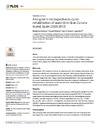Identificador persistente para citar o vincular este elemento:
https://accedacris.ulpgc.es/jspui/handle/10553/36035
| Título: | A long-term retrospective study on rehabilitation of seabirds in Gran Canaria Island, Spain (2003-2013) | Autores/as: | Montesdeoca, Natalia Calabuig Miranda,Pascual Corbera Sánchez, Juan Alberto Orós Montón, Jorge Ignacio |
Clasificación UNESCO: | 3105 Peces y fauna silvestre 310907 Patología |
Palabras clave: | Penguins Spheniscus-Demersus Light-Induced Mortality Oil-Spill Artificial Lights Corys Shearwater, et al. |
Fecha de publicación: | 2017 | Publicación seriada: | PLoS ONE | Resumen: | Aims. The aims of this study were to analyze the causes of morbidity and mortality in a large population of seabirds admitted to the Tafira Wildlife Rehabilitation Center (TWRC) in Gran Canaria Island, Spain, from 2003 to 2013, and to analyze the outcomes of the rehabilitation process. Methods We included 1,956 seabirds (133 dead on admission and 1,823 admitted alive) in this study. Causes of morbidity were classified into nine categories: light pollution (fallout), fishing gear interaction, crude oil, poisoning/intoxication, other traumas, metabolic/nutritional disorder, orphaned young birds, other causes, and unknown/undetermined. The crude and stratified (by causes of admission) rates of the three final disposition categories (euthanasia Er, unassisted mortality Mr, and release Rr), the time until death, and the length of stay were also studied for the seabirds admitted alive. Results Yellow-legged Gull (Larus michahellis) was the species most frequently admitted (46.52%), followed by Cory’s Shearwater (Calonectris diomedea borealis) (20.09%). The most frequent causes of morbidity were light pollution (fallout) (25.81%), poisoning/intoxication (24.69%), and other traumas (18.14%). The final disposition rates were: Er = 15.35%, Mr = 16.29%, and Rr = 68.34%. The highest Er was observed in the ‘other traumas’ category (58.08%). Seabirds admitted due to metabolic/nutritional disorder had the highest Mr (50%). The highest Rr was observed in the light pollution (fallout) category (99.20%). Conclusions This survey provides useful information for the conservation of several seabird species. We suggest that at least the stratified analysis by causes of admission of the three final disposition rates, and the parameters time until death and length of stay at the center should be included in the outcome research of the rehabilitation of seabirds. The high release rate for seabirds (68.34%) achieved at the TWRC emphasizes the importance of wildlife rehabilitation centers for the conservation of seabirds. | URI: | https://accedacris.ulpgc.es/handle/10553/36035 | ISSN: | 1932-6203 | DOI: | 10.1371/journal.pone.0177366 | Fuente: | PLoS ONE [ISSN 1932-6203], v. 12 (5), e0177366 |
| Colección: | Artículos |
Citas SCOPUSTM
20
actualizado el 08-jun-2025
Citas de WEB OF SCIENCETM
Citations
17
actualizado el 18-ene-2026
Visitas
102
actualizado el 10-ene-2026
Descargas
58
actualizado el 10-ene-2026
Google ScholarTM
Verifica
Altmetric
Comparte
Exporta metadatos
Los elementos en ULPGC accedaCRIS están protegidos por derechos de autor con todos los derechos reservados, a menos que se indique lo contrario.
